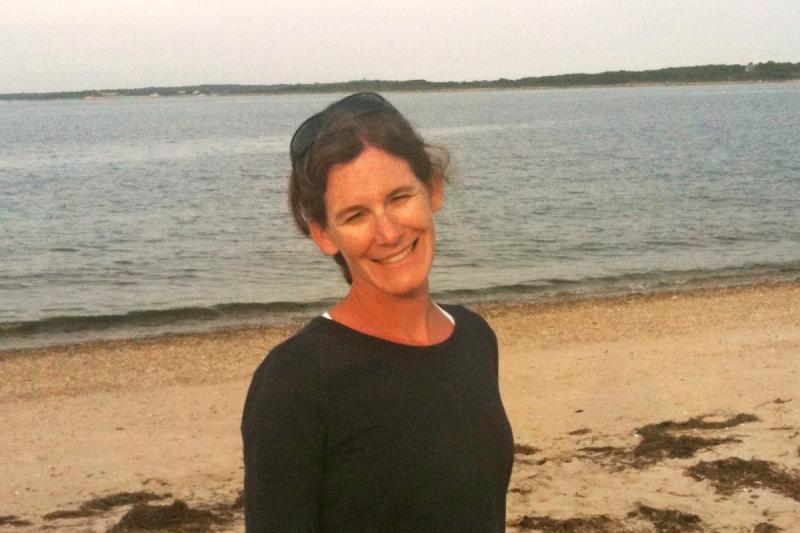Paula Fratantoni is the Branch Chief for the Oceans and Climates Branch. She leads approximately 20 staff that make up two subunits: the Plankton Investigation at the Narragansett, RI laboratory and the Recruitment Processes Group at the Woods Hole laboratory.
1. Can you tell us about your science journey, your career in science?
The summer before my senior year as an undergraduate physics major, I found myself completely uninterested in the field of physics! I was in the first week of a summer internship program, choosing from a list of amazing research opportunities and not one of them appealed to me. One researcher offered the opportunity to study sediment transport in the Chesapeake Bay. The lab was a boat and the discipline was physical oceanography. The next eight weeks set me firmly on the path to become an observational physical oceanographer. I earned my Ph.D. from the University of Miami and was hired as a Postdoctoral Investigator by the Woods Hole Oceanographic Institution (WHOI), joining the research staff thereafter. My deliberate choice to deviate from the traditional tenure track as a Ph.D. scientist at WHOI was unusual for the time, but I was motivated by a strong desire for work-life balance. For the next decade I managed a broad portfolio of federally funded projects. Every grant proposal required a section describing how the research would benefit society and I soon discovered my most successful projects had an obvious broader impact. I left WHOI to join NOAA’s Northeast Fisheries Science Center in 2010, drawn to the idea of research guided by a clear mission. My mid-career move came with an extremely steep learning curve, shifting my collaborations from one discipline to many. I now work with fish biologists, zoologists, behavioral ecologists and social scientists to understand how the ocean influences marine resources on the Northeast U.S. Shelf.
2. Could you share an example of a hurdle or obstacle you experienced during your science journey and how you overcame it?
One of the biggest hurdles I faced in my science career was actually self-imposed. My decision to join NOAA Fisheries represented a conscious commitment to finding success as an interdisciplinary scientist. This was a significant career transition, following 12 years of working largely with other scientists in my own discipline. It has required learning the language of fish biologists, zoologists, behavioral ecologists and social scientists, and developing at least a minimal comprehension of the approaches used by each. It has required me to be comfortable with not having expertise in all aspects of a project. As one of the few only physical oceanographers working at the Northeast Fisheries Science Center, I have transitioned from being the primary lead on research projects – identifying relevant questions and designing experiments to answer them – to collaborator, having my research determined by the questions posed by other researchers. Much of my research now evolves from fisheries-related questions posed by scientists trying to understand how the ocean influences the abundance, distribution, and behavior of fish, invertebrates and marine mammals. These interactions have challenged me to innovate at all levels of my work, developing creative approaches to deploying oceanographic equipment and analyzing data. Interdisciplinary science requires a recognition that success hinges on the expertise of the collective, not the individual. It is precisely this experience with interdisciplinary collaborations that has prepared me to lead the Oceans and Climate Branch, made up of a multi-disciplinary staff conducting a wide range of ecosystem research.
3. What has been your biggest career and/or personal achievement?
In 2016, senior leadership in NOAA Fisheries selected me to participate in NOAA’s prestigious Leadership Competencies Development Program, identifying me as “having high potential for assuming greater leadership responsibilities in NOAA.” I am currently receiving 18 months of advanced leadership training, exposing me to learning opportunities designed to broaden my understanding of NOAA’s strategic vision, mission, and business processes. Through this program, I have developed personal goals based on insights gained from a variety of assessments and exercises. The activities have helped me identify my core values, personality traits, strengths and weakness, and led to the development of a set of personal learning objectives. This time spent developing greater self awareness is already allowing me to interact with others in an emotionally intelligent and more productive manner. I have completed classroom training and conducted executive interviews with senior leadership across NOAA. One of the most valuable experiences so far has been a 3-month developmental assignment, serving as agency liaison to Congress on issues related to NOAA’s Office of Oceanic and Atmospheric Research. This assignment required me to interact with NOAA leadership and Congressional members and staff to prepare briefing materials and provide input on draft legislation related to NOAA’s science. Success depended on strategic communication, the ability to recognize and address sensitive issues, and a well-developed sense of legislative strategy. It offered a valuable opportunity to lead confidently outside my area of technical expertise, relying on the knowledge of others and the strength of my non-technical leadership skills.
4. What advice would you give young women about a career in science?
Embrace challenges as opportunities, especially those that are accompanied by a large red flag of self -doubt. Be brutally honest with yourself about the reasons behind your choices, especially when they mean saying no to an opportunity. Ask yourself if you are making a choice based on fear of failure. Embrace the notion of serendipity, since you never know what is behind the next door you choose to open and you just might surprise yourself! Do one thing every day that scares you!



